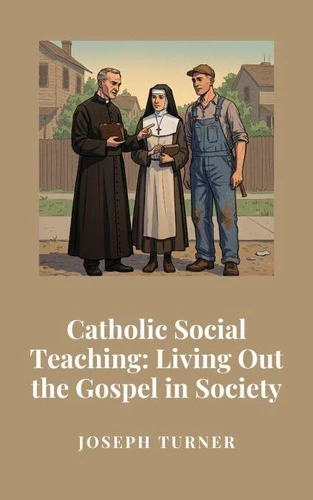Catholic Social Teaching: Living Out the Gospel in Society
Par :Formats :
Disponible dans votre compte client Decitre ou Furet du Nord dès validation de votre commande. Le format ePub est :
- Compatible avec une lecture sur My Vivlio (smartphone, tablette, ordinateur)
- Compatible avec une lecture sur liseuses Vivlio
- Pour les liseuses autres que Vivlio, vous devez utiliser le logiciel Adobe Digital Edition. Non compatible avec la lecture sur les liseuses Kindle, Remarkable et Sony
 , qui est-ce ?
, qui est-ce ?Notre partenaire de plateforme de lecture numérique où vous retrouverez l'ensemble de vos ebooks gratuitement
Pour en savoir plus sur nos ebooks, consultez notre aide en ligne ici
- FormatePub
- ISBN8230088660
- EAN9798230088660
- Date de parution27/02/2025
- Protection num.pas de protection
- Infos supplémentairesepub
- ÉditeurIndependently Published
Résumé
Catholic Social Teaching (CST) has its roots deep within the tradition of the Church, extending from the early Scriptures through the teachings of the Church Fathers, the theological reflections of the Doctors of the Church, and the more modern social encyclicals of the popes. Its foundational principles are not new ideas or modern constructs but are part of a continuous tradition that seeks to understand and apply the Gospel to the social, economic, and political realities of the world.
The origins of Catholic Social Teaching lie in the Scriptures. The Old Testament provides numerous examples of God's concern for justice, care for the poor, and the right treatment of the vulnerable. Prophets such as Amos and Isaiah were bold in denouncing injustice, particularly when it was directed toward the poor and oppressed. They proclaimed God's demand for justice as an essential aspect of Israel's covenantal relationship with Him.
In the New Testament, the life and teachings of Jesus are deeply embedded with a social vision, prioritizing the poor, the oppressed, and the marginalized. In Matthew 25:31-46, Christ directly links social justice with salvation, calling his followers to feed the hungry, clothe the naked, and visit the imprisoned, declaring that whatever is done for the least of His brothers and sisters is done unto Him.
This social dimension of the Gospel is further seen in Christ's many healings, his interactions with tax collectors and sinners, and his radical commandment to love one's neighbor as oneself.
The origins of Catholic Social Teaching lie in the Scriptures. The Old Testament provides numerous examples of God's concern for justice, care for the poor, and the right treatment of the vulnerable. Prophets such as Amos and Isaiah were bold in denouncing injustice, particularly when it was directed toward the poor and oppressed. They proclaimed God's demand for justice as an essential aspect of Israel's covenantal relationship with Him.
In the New Testament, the life and teachings of Jesus are deeply embedded with a social vision, prioritizing the poor, the oppressed, and the marginalized. In Matthew 25:31-46, Christ directly links social justice with salvation, calling his followers to feed the hungry, clothe the naked, and visit the imprisoned, declaring that whatever is done for the least of His brothers and sisters is done unto Him.
This social dimension of the Gospel is further seen in Christ's many healings, his interactions with tax collectors and sinners, and his radical commandment to love one's neighbor as oneself.
Catholic Social Teaching (CST) has its roots deep within the tradition of the Church, extending from the early Scriptures through the teachings of the Church Fathers, the theological reflections of the Doctors of the Church, and the more modern social encyclicals of the popes. Its foundational principles are not new ideas or modern constructs but are part of a continuous tradition that seeks to understand and apply the Gospel to the social, economic, and political realities of the world.
The origins of Catholic Social Teaching lie in the Scriptures. The Old Testament provides numerous examples of God's concern for justice, care for the poor, and the right treatment of the vulnerable. Prophets such as Amos and Isaiah were bold in denouncing injustice, particularly when it was directed toward the poor and oppressed. They proclaimed God's demand for justice as an essential aspect of Israel's covenantal relationship with Him.
In the New Testament, the life and teachings of Jesus are deeply embedded with a social vision, prioritizing the poor, the oppressed, and the marginalized. In Matthew 25:31-46, Christ directly links social justice with salvation, calling his followers to feed the hungry, clothe the naked, and visit the imprisoned, declaring that whatever is done for the least of His brothers and sisters is done unto Him.
This social dimension of the Gospel is further seen in Christ's many healings, his interactions with tax collectors and sinners, and his radical commandment to love one's neighbor as oneself.
The origins of Catholic Social Teaching lie in the Scriptures. The Old Testament provides numerous examples of God's concern for justice, care for the poor, and the right treatment of the vulnerable. Prophets such as Amos and Isaiah were bold in denouncing injustice, particularly when it was directed toward the poor and oppressed. They proclaimed God's demand for justice as an essential aspect of Israel's covenantal relationship with Him.
In the New Testament, the life and teachings of Jesus are deeply embedded with a social vision, prioritizing the poor, the oppressed, and the marginalized. In Matthew 25:31-46, Christ directly links social justice with salvation, calling his followers to feed the hungry, clothe the naked, and visit the imprisoned, declaring that whatever is done for the least of His brothers and sisters is done unto Him.
This social dimension of the Gospel is further seen in Christ's many healings, his interactions with tax collectors and sinners, and his radical commandment to love one's neighbor as oneself.






















